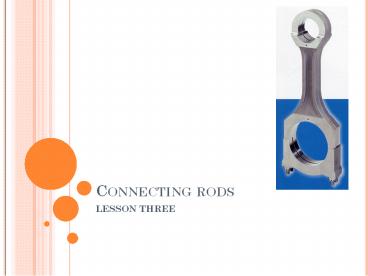Connecting rods PowerPoint PPT Presentation
1 / 24
Title: Connecting rods
1
Connecting rods
- LESSON THREE
2
(No Transcript)
3
- DEFINITION
- A running component connecting the crankshaft to
the piston ( in trunk piston engines ) or to the
crosshead ( in crosshead engines ). - It has both linear ( reciprocating, up-and-down
) rotational ( rotary ) motion.
4
- 2. FUNCTION
- Primary function to transmit the push (
pressure, thrust ) of the piston to the
crankshaft, either directly or indirectly. - Secondary function ( in most designs ) to convey
cooling oil to the pistons which demands for a
quite a large diameter passage.
5
- 3. TYPES
- Marine type The large end bearing is separate
from rod which has a palm end ( T-shaped end )
6
(No Transcript)
7
- 3. TYPES
- Marine type The large end bearing is separate
from rod which has a palm end ( T-shaped end ) - Fixed centre design The upper half of the
crankpin box makes part of the connecting rod./
Alternative design Connecting rod with obliquely
split large end.
8
(No Transcript)
9
- Fork and blade type Vee engine connecting rods.
10
- Articular type Vee engine connecting rods
11
4. ELEMENTS 4.1 Crankpin end ? Bottom end
bearing, lower end bearing, big end bearing,
crankpin bearing, or large end bearing.
12
(No Transcript)
13
- 4. ELEMENTS
- 4.1 Crankpin end ? Bottom end bearing, lower end
bearing, big end bearing, crankpin bearing, or
large end bearing. - Attachment point for the crankpin, carrying a
bearing. - It consists of two half removable shells (
marine type ) held together by bolts and nuts.
The shells have a lining of bearing metal, white
metal or Babbitt ( copper-lead or tin-aluminium
thin flashing of lead or indium to provide for an
anticorrosion layer). - Bearing housing contains cooling oil grooves.
- Between the foot and the box ( bearing housing )
there are shims ( distance pieces, compression
shims, compression plates ) for adjustment of
cylinder compression.
14
4.2 Rod shank It is also called the body and
may take up different forms. It has driling
throughout its length.
15
- 4.2 Rod shank
- It is also called the body and may take up
different forms. It has d driling throughout its
lenght. - 4.3 Gudgeon pin end ? Upper end bearing, top end
bearing, or small end bearing, wristpin bearing. - Upper end bearing is a bushing having an
interference fit ( nip ) in the eye bored in the
rod.
16
(No Transcript)
17
- 4.2 Rod shank
- It is also called the body and may take up
different forms. It has d drilling throughout
its length. - 4.3 Gudgeon pin end ? Upper end bearing, top end
bearing, or small end bearing, wristpin bearing. - Upper end bearing is a bushing having an
interference fit ( nip ) in the eye bored in the
rod. - The eye is a single piece bearing ( bush,
bushing ) pressed into sleeve. - The bushing is of bronze or of cast steel
centrifugally cast bearing metal.
18
- 5. STRESSES
- 5.1 Axial forces ? resulting from gas pressure
and inertia of piston assembly modified by the
side thrust arising in consequence of the
connecting rod crank angle. - The maximum axial load is compressive ( at TDC
). - Tensile stresses occur after firing, due to
piston inertia. - Bending stresses also occur after firing.
- 5.2 Transverse forces ? known as whip, are caused
by inertia effects of the rod mass. - Fortunately axial transverse forces do not
occur at the same time.
19
- 5. STRESSES
- 5.1 Axial forces ? resulting from gas pressure
and inertia of piston assembly modified by the
side thrust arrising in consequence of the
connecting rod crank angle. - The maximum axial load is compressive ( at TDC
). - Tensile stresses occur after firing, due to
piston inertia. - Bending stresses also occur after firing.
- 5.2 Transverse forces ? known as whip, are caused
by inertia effects of the rod mass. - Fortunatly axial transverse forces do not occur
at the same time.
6. LUBRICATION It is carried out through the
shank bore ( drilling ) in running throughout the
shank lenght. It conducts oil from the big end to
the small end for lubrication and to the inside
of piston for its cooling.
20
(No Transcript)
21
(No Transcript)
22
7. WITHDRAWAL ( Pulling out, removal ) In most
designs through the upper end. In few designs the
piston and the connecting rod are withdrawn
downwards.
23
(No Transcript)
24
(No Transcript)

